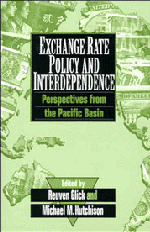Book contents
- Frontmatter
- Contents
- List of contributors
- Preface
- Exchange rate policy and interdependence
- 1 Overview
- I International financial market integration
- II Choice of exchange rate regimes
- III Intervention and sterilization policies
- 10 Monetary policy, intervention, and exchange rates in Japan
- 11 The signaling effect of foreign exchange intervention: the case of Japan
- 12 Sterilization of the monetary effects of current account surpluses and its consequences: Korea, 1986–1990
- IV Prospects for a yen bloc
- Index
10 - Monetary policy, intervention, and exchange rates in Japan
Published online by Cambridge University Press: 04 May 2010
- Frontmatter
- Contents
- List of contributors
- Preface
- Exchange rate policy and interdependence
- 1 Overview
- I International financial market integration
- II Choice of exchange rate regimes
- III Intervention and sterilization policies
- 10 Monetary policy, intervention, and exchange rates in Japan
- 11 The signaling effect of foreign exchange intervention: the case of Japan
- 12 Sterilization of the monetary effects of current account surpluses and its consequences: Korea, 1986–1990
- IV Prospects for a yen bloc
- Index
Summary
Introduction
Until the end of the Bretton Woods system in the early 1970s, Japanese monetary policy was driven by concern about maintaining the international value of the yen fixed. The need to maintain fixed exchange rate parities limited the degree of discretion by the Bank of Japan in its conduct of monetary policy. Balance–of–payments deficits and downward pressure on the yen necessitated contractionary policy and a growth slowdown; surpluses and upward yen pressure required expansionary policy.
With the exchange rate anchor for monetary policy eliminated at the end of the Bretton Woods era, the Bank of Japan (BOJ) switched to domestic price stability as the main target of policy, with the strategic aim of reducing the inflation rate. The BOJ's success in maintaining the lowest rate of price inflation among industrial countries since the late 1970s has been attributed to a so–called money–focused monetary policy (Suzuki, 1985; Fukui, 1986). The conventional wisdom is that this money–focused approach has resulted in the placing of relatively little weight on the state of the economy when determining monetary policy (e.g., Friedman 1985).
However, Hamada and Hayashi (1985), Ito (1989), and Bryant (1991) express doubt that the BOJ places much weight on limiting deviations of any given money aggregate from targeted values and assert that the BOJ does not focus on any single target. A number of recent papers have focused on the role of external considerations in the determination of BOJ monetary policy.
- Type
- Chapter
- Information
- Exchange Rate Policy and InterdependencePerspectives from the Pacific Basin, pp. 225 - 257Publisher: Cambridge University PressPrint publication year: 1994
- 5
- Cited by

